- Home >
- Testing >
- Testing and Evaluation >
- Laboratories and Facilities >
- Countermeasures
Countermeasures
WSMR has extensive and diverse countermeasure abilities available for a wide range of sensors and weapon systems testing ranging from, but not limited to, visual to infrared to radar countermeasures. The countermeasure facilities in this section are owned and operated by the Center for Countermeasures(CCM) at WSMR. Electronic Warfare countermeasures are available from Army Research Laboratoryorganizations at WSMR and are listed under Electronic Warfare facilities.
Digital Enhanced Seeker Van (DESV)
The Digital Enhanced Seeker Van (DESV) and its Kineto Tracking Mount (KTM) are used to collect missile seeker data at 800 Kbits/sec. Equipped with high-end PC-based computers, it can simultaneously collect data from eight different types of seekers mounted on the KTM. The DESV can collect up to eight channels of data per seeker and data availability is near real-time. Seekers used are both domestic and foreign.
Laser Laboratory Facilities
The Center maintains and operates approximately 100 lasers from the deep ultraviolet through the far-infrared spectrum. A variety of non-coherent sources of various wavelengths are in inventory. Calibration, diagnostic and repair equipment and instrumentation used to support laboratory and field testing are also maintained and operated.
Millimeter Wave ECM Threat Simulator (METS)
The Center uses many lasers and non-coherent sources in CM field tests. These lasers and non-coherent sources cover the spectrum from ultraviolet to far infrared. These lasers provide false target generation against laser guided PGW systems and non-destructive CM effects against threat warning systems and targeting systems. Most of the non-coherent sources are unique.
Millimeter Wave Laboratory (MMW)
The Millimeter Wave Laboratory (MMW) capabilities include collection of data on reflectivity, scattering, absorption, and penetration by MMW emissions. Active jamming and other types of countermeasure procedures are also used during laboratory and field testing.
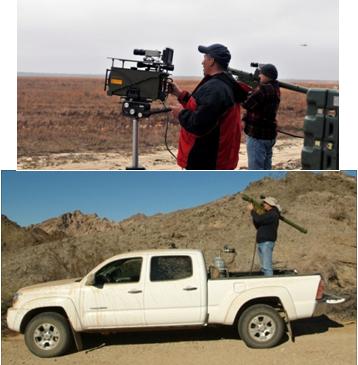 MANPADS Simulator
MANPADS Simulator
The Center for Countermeasures owns and operates equipment that simulates a MANPADS threat. The combination of the ultraviolet Mallina - Missile Warning System (MWS) "Stimulator" and actual MANPADS (SA-7, etc.) replicates a realistic threat environment for military training exercises and pre-deployment events. In addition to the stimulation of the air platforms' MWS, the video capture of the MANPADS tracking and engagement, as well as aircrew reaction is recorded and provided to the military organization as requested.
Passive Countermeasures
Many Passive Countermeasures are available.
EO/IR
Obscurants - Smoke Generator: Coyote M-56 [fog oil, graphite, chaff (millimeter-wave)]
Camouflage, Concealment, and Deception
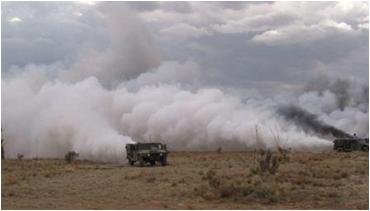
Decoys: Inflatable
T-72 desert/woodland camouflage
SCUD TEL desert/woodland camouflage
SA-6
ZIL
IR Suppression:
Exhaust Suppression Kits (T-72/BMP)
Camouflage Nets:
Standard U.S. Military Camouflage
Swedish Barracuda
ULCANS; Desert/Woodland/Concrete Runway
 Remote Launcher System
Remote Launcher System
Highly mobile Remote Launcher Systems (RLS) are available in different types of configurations to remotely launch a variety of both domestic and foreign infrared-guided, shoulder-fired missiles. Each RLS is equipped with time annotated video recording capabilities to capture events of the missile flight. The RLS is dual shot capable with a required 30-45 minute turnaround time before re-engagement. The RLS is self-contained and fully transportable to any location.
Active Countermeasures
Many Active Countermeasures are available:
Pyrotechnics
Obscurant Grenades (Multi-band: 66- millimeter smoke MBS; Phosphorus: L8A3)
Flamethrower (burning diesel)
Non-Pyrotechnic
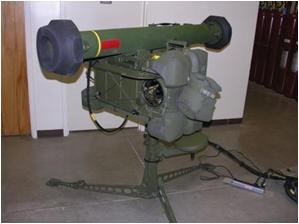
Lamps: MIRS, CERMAC
Narrowband Pulsed and CW Lasers
Ultraviolet (200-400 nm)
Visible (400-800 nm)
Mid-IR (800-5000 nm): Low and High PRF; Repeater: Fast, Damn Fast; Beamrider
Far IR ( > 5000 nm)
False Target Generator; Universal Semi-Active-Laser-Guidance Jammer
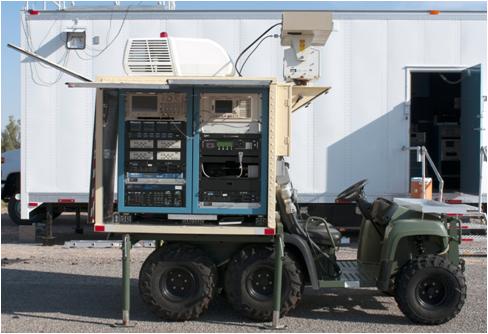 Millimeter-Wave Electronic Attack Simulator (MEAS)
Millimeter-Wave Electronic Attack Simulator (MEAS)
The Center for Countermeasures owns and operates the Millimeter-Wave Electronic Attack Simulator (MEAS), which is a radio frequency repeater, transponder, and barrage noise jammer that can respond to both continuous wave and pulse radar systems. The MEAS system is comprised of a control van and a mobile jammer (test bed). The test bed can be remotely operated using a 500 meter fiber optic cable from the van or as a stand-alone unit.
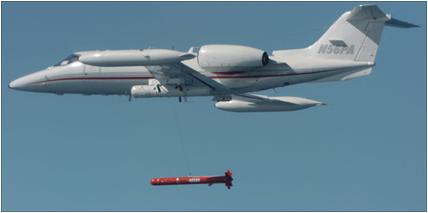 Towed Airborne Plume Simulator
Towed Airborne Plume Simulator
The Center for Countermeasures owns and operates the Towed Airborne Plume Simulator (TAPS), which is a missile simulator that can be towed behind aircraft. The towed simulator resolves shortfalls of emulating spatial / temporal signatures for testing missile warning system and infrared countermeasures systems.
Joint Mobile Infrared Countermeasure Testing System (JMITS)
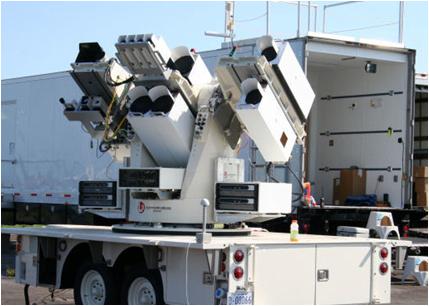
The Center for Countermeasures owns and operates the Joint Mobile Infrared Countermeasure Testing System (JMITS), a self-contained, ground-based, mobile unit designed to test aircraft countermeasures to MANPADS threats. The system consists of a tracking mount outfitted with missile simulator capable of transmitting threat representative UV and IR missile signatures. In addition the JMITS has IR and UV radiometers, a static threat seeker suite, and an atmospheric measurement suite for characterizing atmospheric conditions. The Center has two JMITS units. This system, developed in 2008, corrected many T&E shortfalls of existing open-air infrared countermeasure test systems.
Radiometric Support
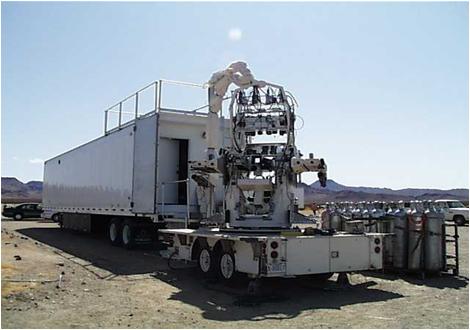 The Center has developed a "world-class" radiometric instrumentation suite dedicated to signature characterization of a host of military assets and threats. The sensor suite consists of a variety of 3 - 5 micron Fourier transform spectrometers (FTS) and an 8 - 12 micron FTS. The premier spectrometer is a custom-made ultra-violet/visible/infrared FTS. Spectroscopic analysis of gaseous emissions from combustion by-products includes investigations at the atomic and molecular level. The imager suite consists of several 3 - 5 micron imagers, an 8 - 12 micron imager, a dedicated 8 - 12 micron imager used for contrast tracking, a wide field-of view (FOV) visible scene imager and an extreme narrow FOV tri-focal imaging system. Meteorological data, including ozone concentrations, are recorded in-situ and can be input in near real-time to an advanced atmospheric transmittance/radiance model.
The Center has developed a "world-class" radiometric instrumentation suite dedicated to signature characterization of a host of military assets and threats. The sensor suite consists of a variety of 3 - 5 micron Fourier transform spectrometers (FTS) and an 8 - 12 micron FTS. The premier spectrometer is a custom-made ultra-violet/visible/infrared FTS. Spectroscopic analysis of gaseous emissions from combustion by-products includes investigations at the atomic and molecular level. The imager suite consists of several 3 - 5 micron imagers, an 8 - 12 micron imager, a dedicated 8 - 12 micron imager used for contrast tracking, a wide field-of view (FOV) visible scene imager and an extreme narrow FOV tri-focal imaging system. Meteorological data, including ozone concentrations, are recorded in-situ and can be input in near real-time to an advanced atmospheric transmittance/radiance model.
The Seeker Radiometrics Test Van is used to collect, analyze, archive, and distribute static infrared-guided seeker test data collected from multiple seekers simultaneously during field countermeasure test programs. The Van assists the DoD tester to determine effectiveness of expendable IRCMs in the protection of aircraft platforms. Up to eight seekers can be mounted on the van. Additionally, the van has suite of radiometric imagers and spectrometers for collecting signature information.
